Paper Menu >>
Journal Menu >>
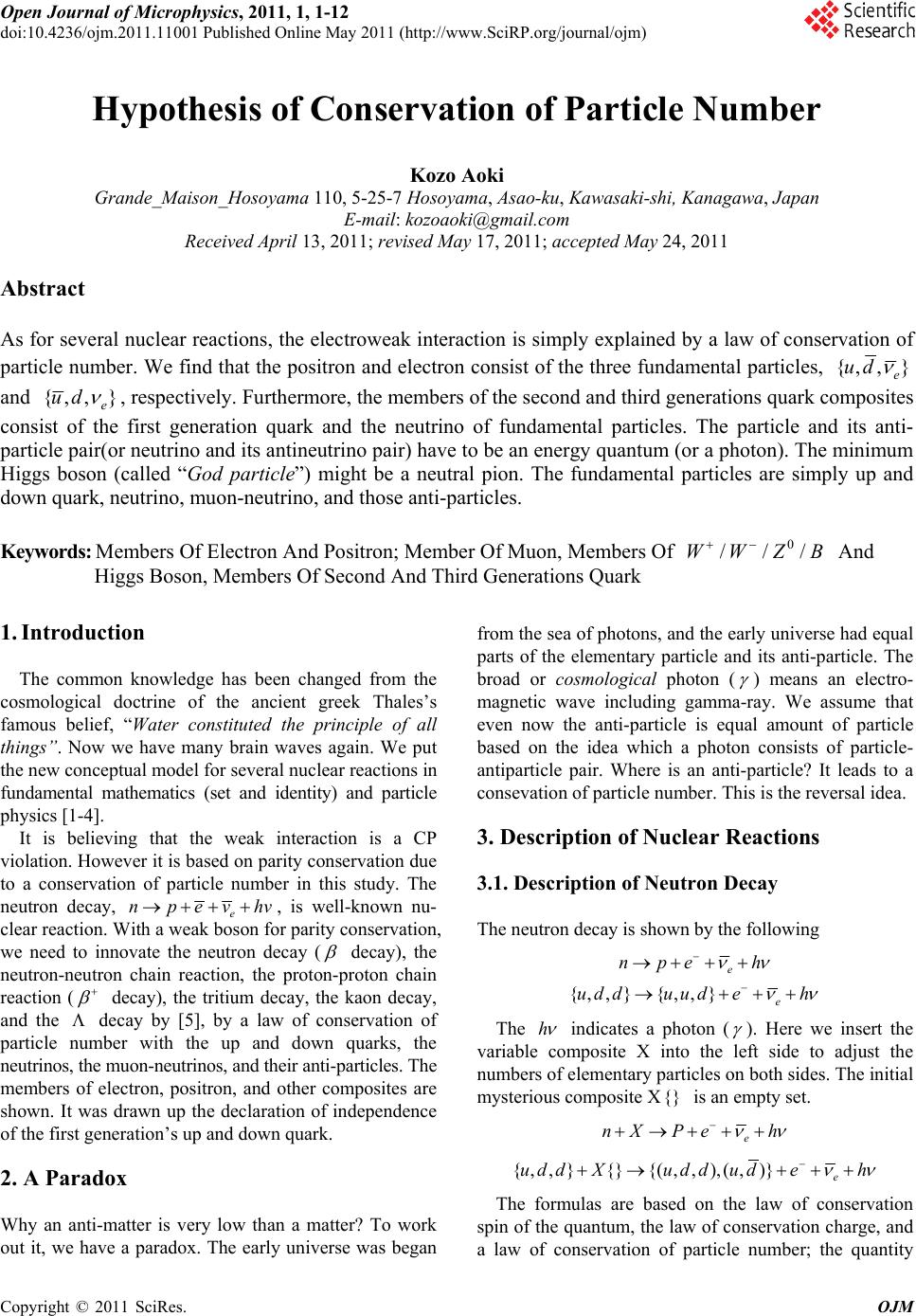 Open Journal of Microphysics, 2011, 1, 1-12 doi:10.4236/ojm.2011.11001 Published Online May 2011 (http://www.SciRP.org/journal/ojm) Copyright © 2011 SciRes. OJM Hypothesis of Conservation of Particle Number Kozo Aoki Grande_Maison _Hosoyama 110, 5-25-7 Hosoyama, Asao-ku, Kawasaki-shi, Kanagawa, Japan E-mail: kozoaoki@gmail.com Received April 13, 2011; revised May 17, 2011; accepted May 24, 2011 Abstract As for several nuclear reactions, the electroweak interaction is simply explained by a law of conservation of particle number. We find that the positron and electron consist of the three fundamental particles, {, ,} e ud and {, ,} e ud , respectively. Furthermore, the members of the second and third generations quark composites consist of the first generation quark and the neutrino of fundamental particles. The particle and its anti- particle pair(or neutrino and its antineutrino pair) have to be an energy quantum (or a photon). The minimum Higgs boson (called “God particle”) might be a neutral pion. The fundamental particles are simply up and down quark, neutrino, muon-neutrino, and those anti-particles. Keywords: Members Of Electron And Positron; Member Of Muon, Members Of And Higgs Boson, Members Of Second And Third Generations Quark 0 ///WWZB 1. Introduction The common knowledge has been changed from the cosmological doctrine of the ancient greek Thales’s famous belief, “Water constituted the principle of all things”. Now we have many brain waves again. We put the new conceptual model for several nuclear reactions in fundamental mathematics (set and identity) and particle physics [1-4]. It is believing that the weak interaction is a CP violation. However it is based on parity conservation due to a conservation of particle number in this study. The neutron decay, e npevhv , is well-known nu- clear reaction. With a weak boson for parity conservation, we need to innovate the neutron decay ( decay), the neutron-neutron chain reaction, the proton-proton chain reaction ( decay), the tritium decay, the kaon decay, and the decay by [5], by a law of conservation of particle number with the up and down quarks, the neutrinos, the muon-neutrinos, and their anti-particles. The members of electron, positron, and other composites are shown. It was drawn up the declaration of independence of the first generation’s up and down quark. 2. A Paradox Why an anti-matter is very low than a matter? To work out it, we have a paradox. The early universe was began from the sea of photons, and the early universe had equal parts of the elementary particle and its anti-particle. The broad or cosmological photon ( ) means an electro- magnetic wave including gamma-ray. We assume that even now the anti-particle is equal amount of particle based on the idea which a photon consists of particle- antiparticle pair. Where is an anti-particle? It leads to a consevation of particle number. This is the reversal idea. 3. Description of Nuclear Reactions 3.1. Description of Neutron Decay The neutron decay is shown by the following {,, }{,, } e e npe h udduud eh The h indicates a photon ( ). Here we insert the variable composite X into the left side to adjust the numbers of elementary particles on both sides. The initial mysterious composite X{} is an empty set. e nX Peh {,, }{}{(,,),(,)}e uddXudd udeh The formulas are based on the law of conservation spin of the quantum, the law of conservation charge, and a law of conservation of particle number; the quantity 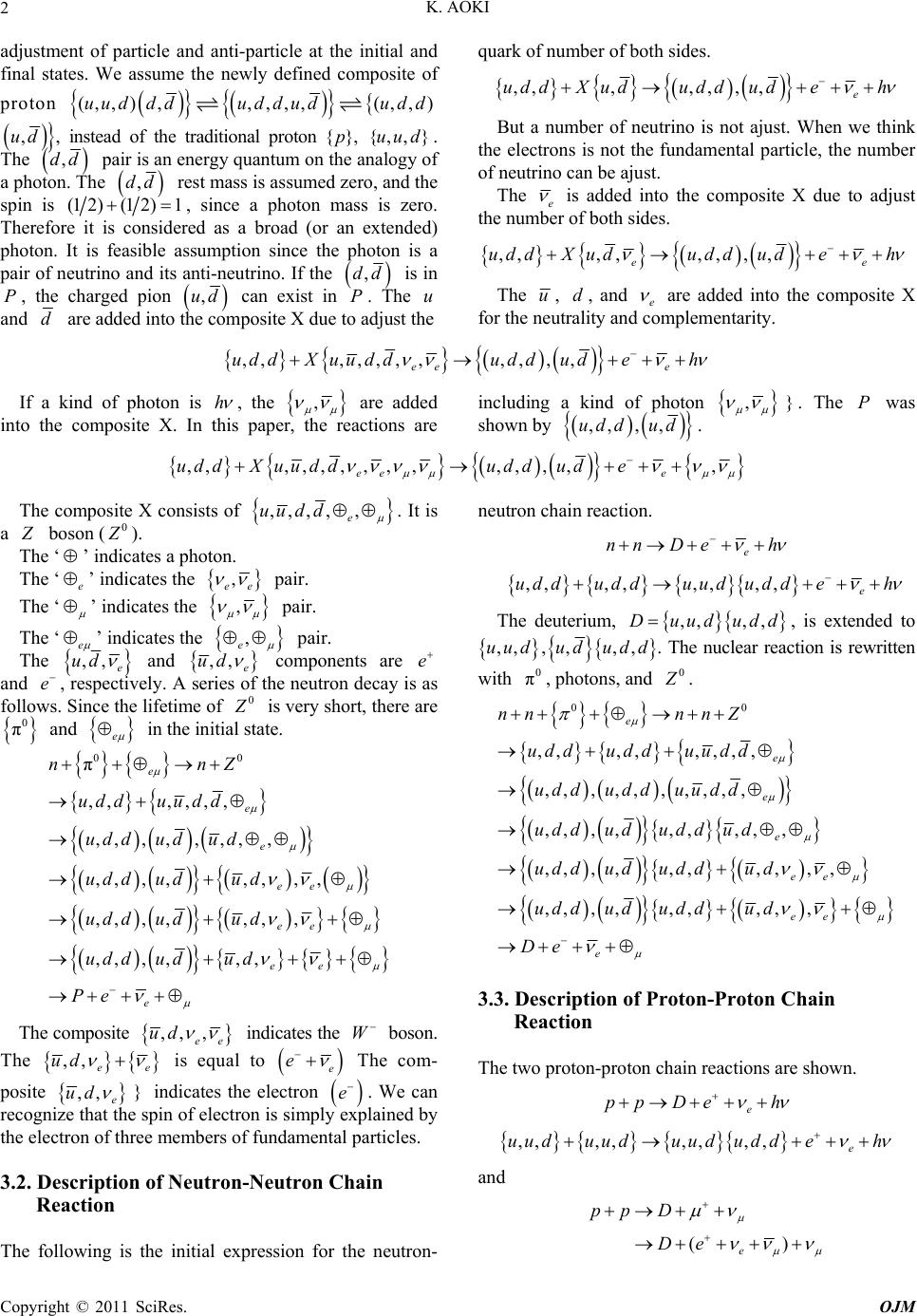 K. AOKI 2 adjustment of particle and anti-particle at the initial and final states. We assume the newly defined composite of proton (,, ),, , ,,(, , )uud dduddududd ,ud , instead of the traditional proton {, . The }p{, ,}uu d ,dd quark of number of both sides. ,,,,,, ,e uddX ududdudeh But a number of neutrino is not ajust. When we think the electrons is not the fundamental particle, the number of neutrino can be ajust. pair is an energy quantum on the analogy of a photon. The ,dd rest mass is assumed zero, and the spin is (1 2)(1 2)1, since a photon mass is zero. Therefore it is considered as a broad (or an extended) photon. It is feasible assumption since the photon is a pair of neutrino and its anti-neutrino. If the ,dd is in , the charged pion P ,ud The e is added into the composite X due to adjust the number of both sides. ,,,,,,, , ee uddX ududdudeh can exist in . The and Pu d are added into the composite X due to adjust the The u, , and e d are added into the composite X for the neutrality and complementarity. ,,,,,, ,,,,, ee e uddX uudduddudeh If a kind of photon is h , the , are added into the composite X. In this paper, the reactions are including a kind of photon , }. The was shown by P ,,, ,uddud . ,,,,,,,, ,,,,,, ee e uddX uudduddude The composite X consists of ,,,, , e uudd . It is a Z boson (0 Z ). The ‘’ indicates a photon. The ‘’ indicates the e , ee pair. The ‘ ’ indicates the , pair. The ‘e ’ indicates the , e pair. The ,,ud e and ,, e ud components are e and , respectively. A series of the neutron decay is as follows. Since the lifetime of e 0 Z is very short, there are and 0 π e in the initial state. 00 π ,, ,,,, ,,, ,,,,, ,,,,,,,, ,,, ,,,, ,,, ,,, e e e ee ee ee e nnZ udd uudd udd udud udd udud udd udud udd udud Pe The composite ,, , ee ud indicates the W boson. The ,, ee ud is equal to e e The com- posite ,,ud e } indicates the electron . We can recognize that the spin of electron is simply explained by the electron of three members of fundamental particles. e 3.2. Description of Neutron-Neutron Chain Reaction The following is the initial expression for the neutron- neutron chain reaction. e nn Deh ,,,,,, ,,e uddudduud uddeh The deuterium, ,, ,,Duud udd, is extended to ,,dd,,, ,uudud u. The nuclear reaction is rewritten with , photons, and 0 π0 Z . 00 ,, ,, ,,,, ,, ,,, ,,,,, ,,, ,,,,,, ,,,,,,,,, , ,,, ,,,,,, e e e e ee ee e nn nnZ udd udd uudd udd udd uudd uddududd ud udd ududdud udd ududdud De 3.3. Description of Proton-Proton Chain Reaction The two proton-proton chain reactions are shown. e pp Deh ,,,,,, ,,e uuduuduud uddeh and () e ppD De Copyright © 2011 SciRes. OJM 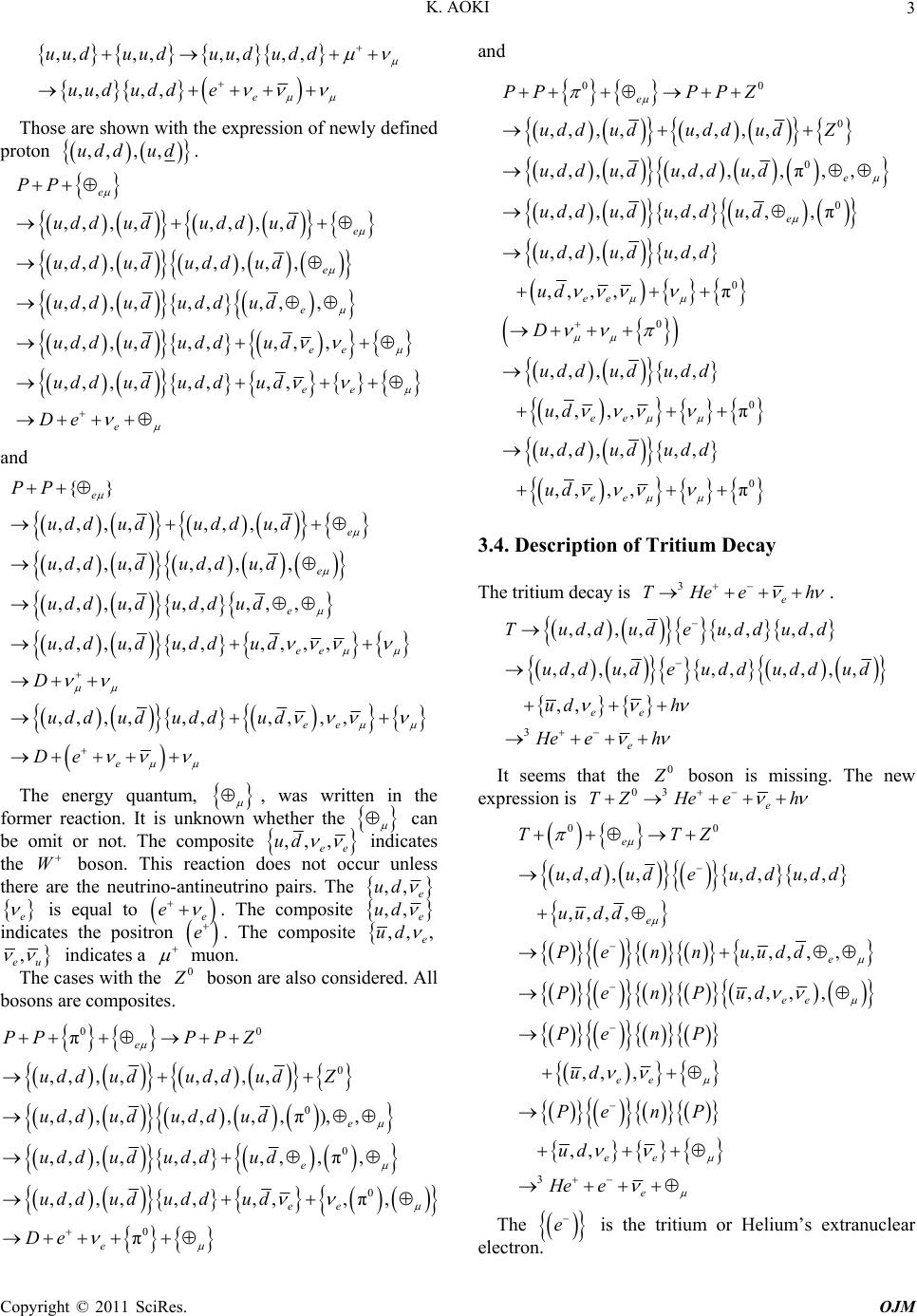 K. AOKI3 ,,,,,, ,, ,, ,,e uuduuduud udd uud udde Those are shown with the expression of newly defined proton ,,, ,uddud. ,,, ,,,, , ,,, ,,,, ,, ,,, ,,,,,, ,,, ,,,,,, ,,, ,,,,, e e e e ee ee e PP udd ududd ud udd ududd ud udd ududdud udd ududdud udd ududdud De and {} ,,, ,,,, , ,,, ,,,, ,, ,,, ,,,,,, ,, ,,,,,,,, ,,,,,,,,,, e e e e ee ee e PP udd ududd ud udd ududd ud uddududd ud udd ududdud D udd ududdud De The energy quantum, , was written in the former reaction. It is unknown whether the can be omit or not. The composite ,, ,ud ee indicates the boson. This reaction does not occur unless there are the neutrino-antineutrino pairs. The W e ,,ud e is equal to e e . The composite e ,,ud indicates the positron . The composite e ,,, e ud u , e indicates a 0 muon. The cases with the Z boson are also considered. All bosons are composites. 00 0 0 0 0 0 π ,, ,,,, ,, ,, ,,,, ,,,π), , ,,, ,,,,,,π, ,,, ,,,,,,π, π e e e ee e PP PPZ udd ududd udZ udd ududd ud udd ududdud udd ududdud De and 00 0 0 0 0 0 0 ,,, ,,,, , ,,, ,,,, ,,π,, ,,, ,,,,,,π ,,, ,,, ,,,,π ,,, ,,, ,,,,π ,,, ,,, ,, e e e ee ee PP PPZ udd ududd udZ udd ududdud udd ududdud udd ududd ud D udd ududd ud udd ududd ud 0 ,, π ee 3.4. Description of Tritium Decay The tritium decay is 3 e THee h . 3 ,,, ,,,,, ,, ,,,,,, ,, ,,ee e Tuddudeudd udd udd udeuddudd ud ud h He eh It seems that the 0 Z boson is missing. The new expression is 03 e TZHeeh 00 3 ,,, ,,,,, ,,,, ,,,, , ,, ,, ,,, ,, e e e ee ee ee e TTZ uddudeudd udd uudd Penn uudd Pe nPud Pe nP ud Pe nP ud He e The e is the tritium or Helium’s extranuclear electron. Copyright © 2011 SciRes. OJM 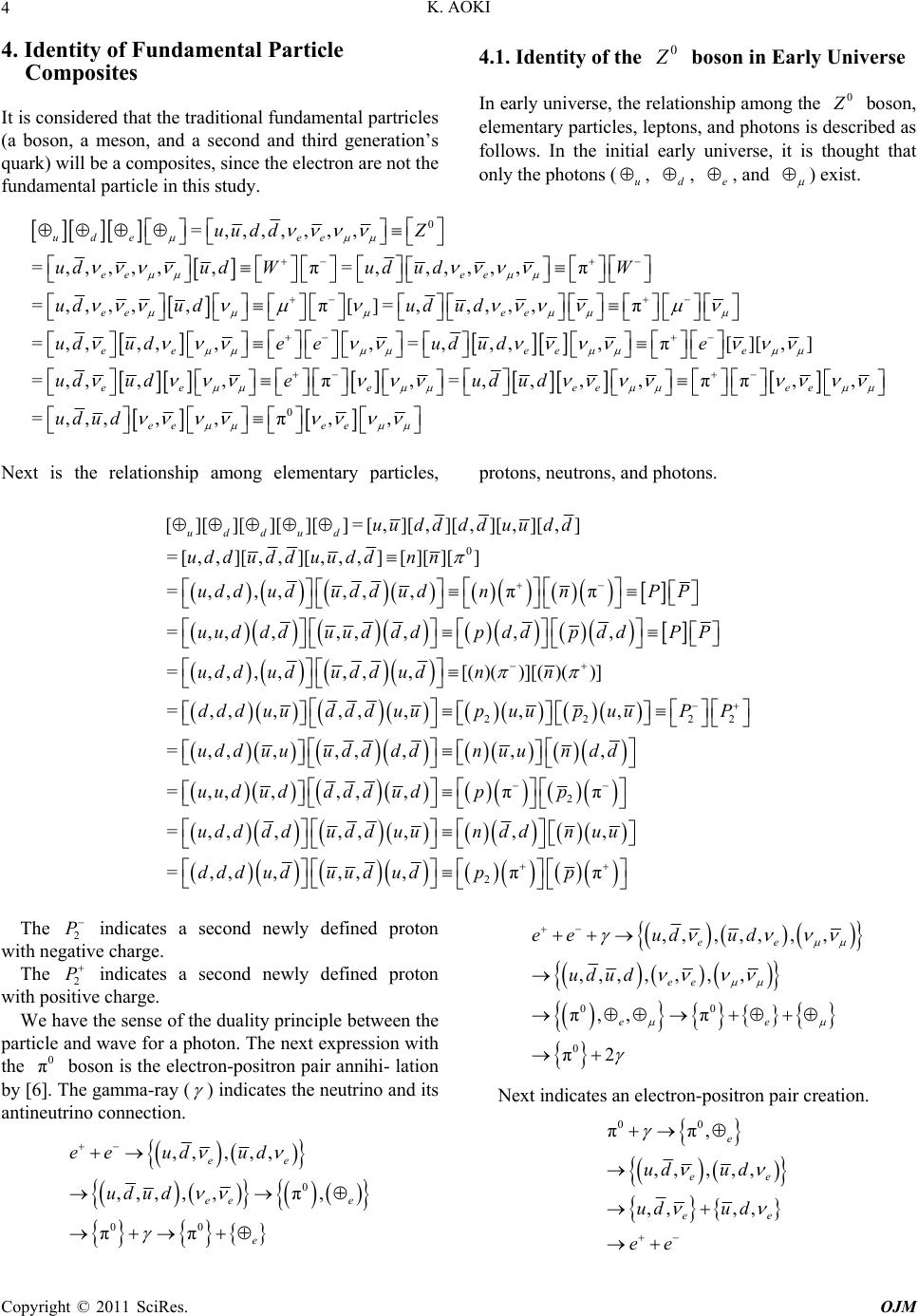 K. AOKI Copyright © 2011 SciRes. OJM 4 4. Identity of Fundamental Particle Composites 4.1. Identity of the 0 Z boson in Early Universe In early universe, the relationship among the 0 Z boson, elementary particles, leptons, and photons is described as follows. In the initial early universe, it is thought that It is considered that the traditional fundamental partricles (a boson, a meson, and a second and third generation’s quark) will be a composites, since the electron are not the fundamental particle in this study. only the photons (u , d , , and e ) exist. 0 =,,,,,, , =,,,, ,,π=, ,,,,,π = ,,,,,π[]= ,,,,,π ude ee ee ee ee ee uudd Z ududWud udW ududud ud =,,,,,, =,,,,π[][,] =,, ,,π,=, ,,,ππ, eeee e ee eeeee ududeeud ude ududeud ud 0 , =,,, ,,π,, ee ee udud Next is the relationship among elementary particles, protons, neutrons, and photons. 0 [][][][][]=[,][,][,][,][,] =[ ,,][,,][ ,,,][ ][][] =,,,,,, ,ππ =,, ,,,,,, =,,,,,, , uddud uu dddduu dd uddudduuddnn uddudud dudnnPP uuddduudd dpddpd dPP uddudud dud 22 2 2 [( )()][()()] =,, ,,,,,, =,, ,,,,,, =,, ,,,,ππ =,,,,, ,, nn ddduudd duupuupuuPP udduuuddddnuundd uud uddddudpp uddd dud duund dn 2 2 , =,, ,,,,ππ uu ddd uduududpp 00 0 ,, ,,, , , ,,, ,,,, π,, π π2 ee ee ee eeud ud udud The 2 indicates a second newly defined proton with negative charge. P The 2 indicates a second newly defined proton with positive charge. P We have the sense of the duality principle between the particle and wave for a photon. The next expression with the boson is the electron-positron pair annihi- lation by [6]. The gamma-ray ( 0 π ) indicates the neutrino and its antineutrino connection. Next indicates an electron-positron pair creation. 00 ππ, ,,, ,, ,, ,, e ee ee ud ud ud ud ee 0 00 ,,, ,, ,,, ,,π, ππ ee ee e e eeud ud udud 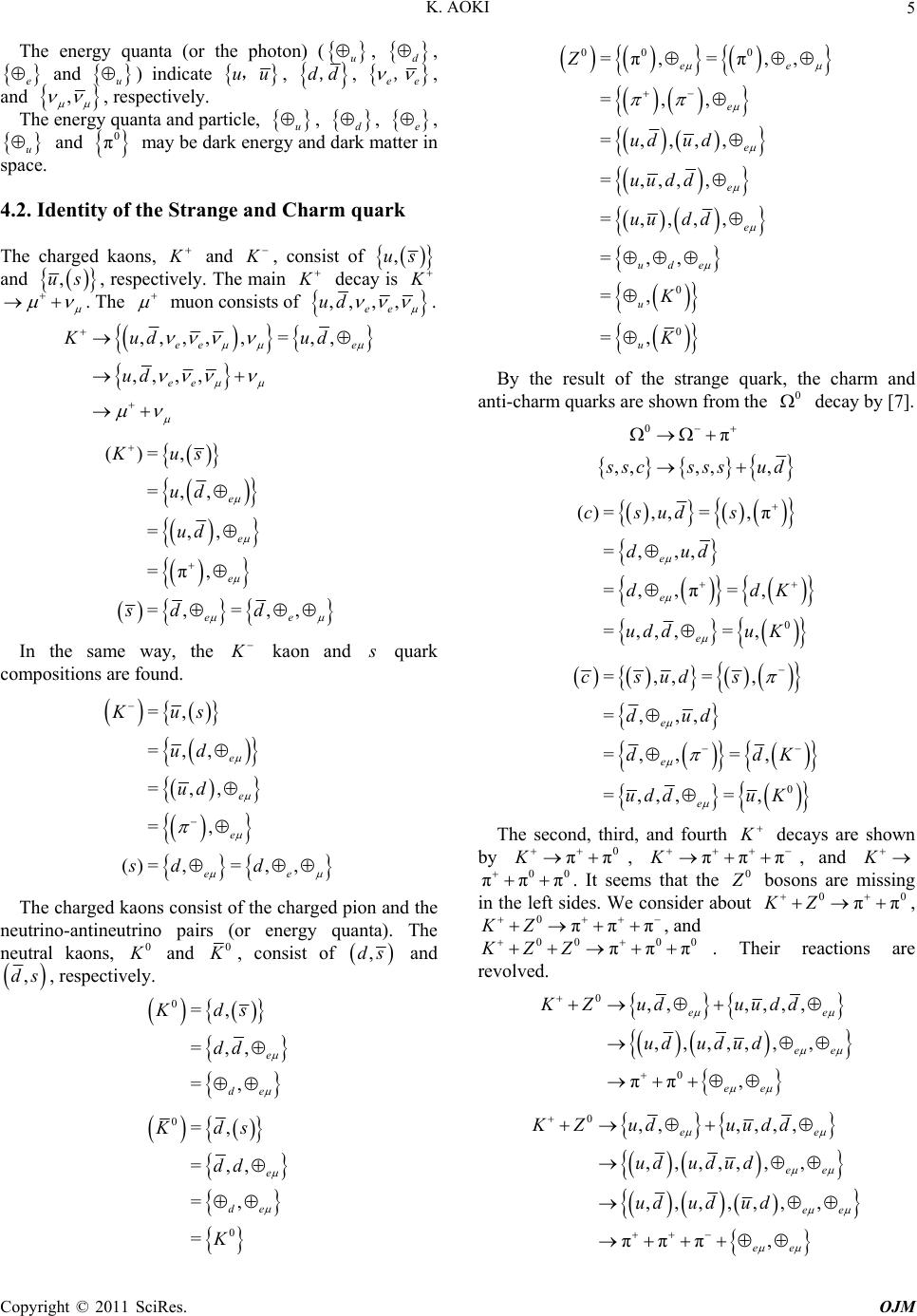 K. AOKI5 The energy quanta (or the photon) ( u, d , and ) indicate e u uu,, dd,, ee ,, and , , respectively. The energy quanta and particle, , d, u e , and may be dark energy and dark matter in space. u 0 π 4.2. Identity of the Strange and Charm quark The charged kaons, K and K , consist of ,us and ,us , respectively. The main K decay is K . The muon consists of ,,, , ee ud . ,,,,,= ,, ,,,, ee e ee Kud ud ud ()=, =,, =,, =π, =, =,, e e e ee Kus ud ud sd d In the same way, the K kaon and s quark compositions are found. =, =,, =,, =, ()=, =,, e e e ee Kus ud ud sd d The charged kaons consist of the charged pion and the neutrino-antineutrino pairs (or energy quanta). The neutral kaons, 0 K and 0 K , consist of ,ds and ,ds , respectively. 0=, =,, =, e de Kds dd 0 0 =, =,, =, = e de Kds dd K 00 0 0 0 =π,=π,, =,, =,,,, =,,,, =,,,, =,, =, =, ee e e e e ude u u Z ud ud uu d d uu dd K K By the result of the strange quark, the charm and anti-charm quarks are shown from the decay by [7]. 0 0π ,,,, , s scsss ud 0 ()= ,,= ,π =, ,, =, ,π=, =,,, =, e e e csud s dud dd udduK K 0 =,,=, =, ,, =, ,=, =,,, =, e e e csuds dud dd uddu K K The second, third, and fourth K decays are shown by , 0 ππK πππK , and K 00 πππ . It seems that the 0 Z bosons are missing in the left sides. We consider about , 00 ππ KZ 0ππKZ π 00 KZZ 00 πππ , and . Their reactions are revolved. 0 0 ,, ,,,, ,,,,,, , ππ , ee ee ee KZ uduudd ud udud 0,, ,,,, ,,,,,, , ,,,,,, , πππ, ee ee ee ee KZ uduudd ud udud ud ud ud Copyright © 2011 SciRes. OJM 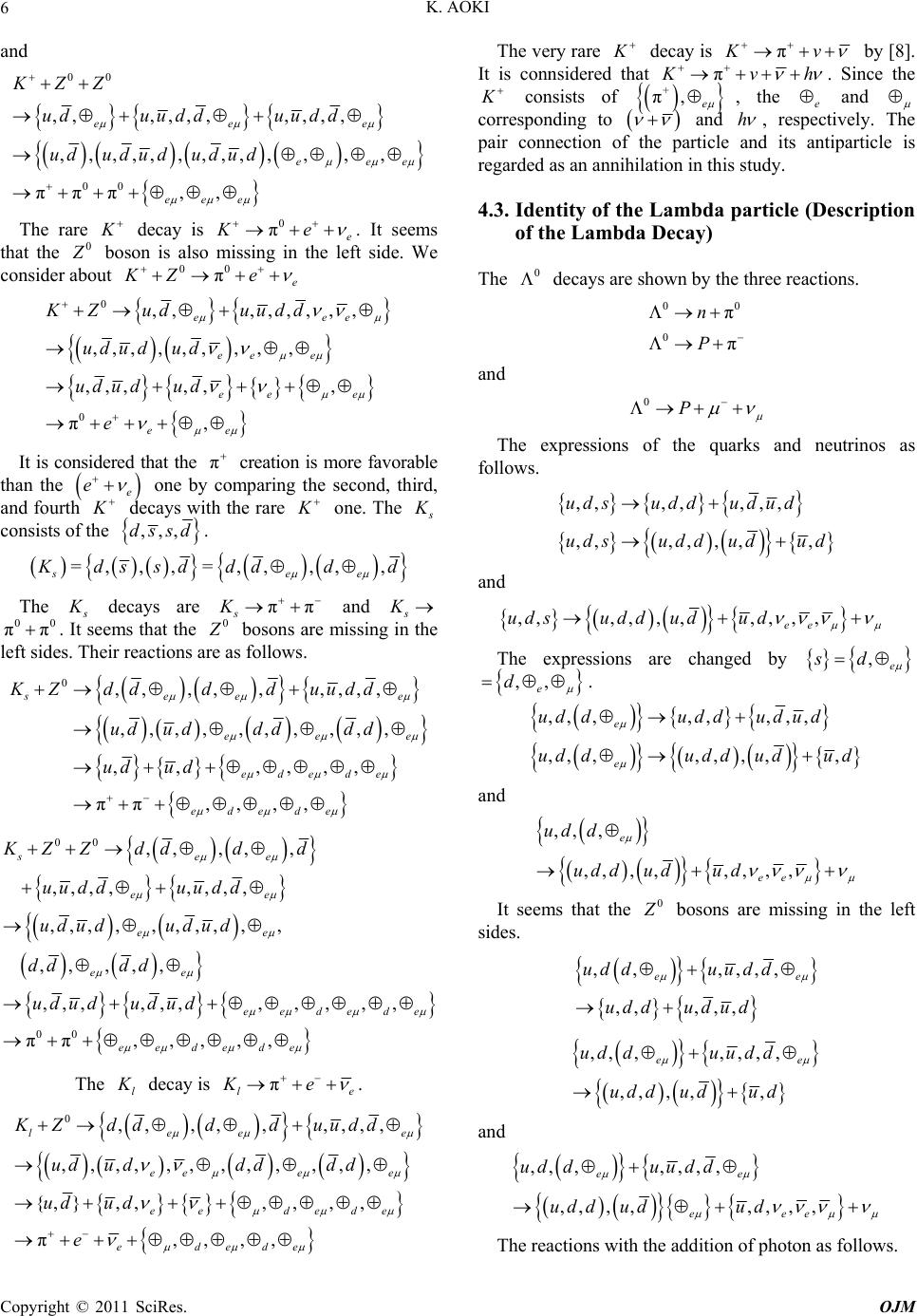 K. AOKI 6 and 00 00 ,, ,,,,,,,, ,, ,,,, ,,,,,,, πππ ,, eee ee eee KZZ ud uudd uudd ududud udud e The rare K decay is 0 πe Ke . It seems that the 0 Z boson is also missing in the left side. We consider about 00 πe eKZ 0 0 ,, ,,,,,, ,,,, ,,, ,, ,,, ,,, π, eee ee e ee e ee KZ uduudd udud ud udud ud e It is considered that the creation is more favorable than the π e e one by comparing the second, third, and fourth K decays with the rare K one. The s K consists of the ,,,dssd . =,,,=,, ,, , see K ds sddddd The s K decays are and s . It seems that the ππ s K 0 K 0 ππ0 Z bosons are missing in the left sides. Their reactions are as follows. 0,, ,, ,,,,, ,,,, ,,, ,,, ,, ,,,, ππ ,, ,, see eee edede edede KZdddd uudd ududdddd ud ud e 00 00 ,, ,, , ,,,,,,,, ,,, ,,,,, ,, ,,,,, ,,,,,,,, ,, , ππ ,,,,, see ee ee ee e e de de e e de de KZZ dddd uudd uudd udud udud dd dd udud udud The l K decay is π le Ke . 0,, ,, ,,,,, ,,,, ,, ,,,,,, {, }, ,,,,, π,, ,, lee eee e ee dede edede KZdddd uudd ududdddd ud ud e The very rare K decay is πKv by [8]. It is connsidered that π K vh . Since the K consists of + π,e , the e and corresponding to and h , respectively. The pair connection of the particle and its antiparticle is regarded as an annihilation in this study. 4.3. Identity of the Lambda particle (Description of the Lambda Decay) The 0 decays are shown by the three reactions. 00 0 π π n P and 0P The expressions of the quarks and neutrinos as follows. ,,,, ,,, ,,,,, ,, udsudd udud udsudd udud and ,,,,,,,, , , ee udsudd udud The expressions are changed by ,e sd ,, e d . ,, ,,,,,, ,,,,,, ,, e e ud duddudud ud duddudud and ,,, ,, ,,,,,, e ee ud d udd udud It seems that the 0 Z bosons are missing in the left sides. ,, ,,,, ,, ,,, ee ud duudd udd udud ,, ,,,,, ,,, ,, ee ud duudd udd udud e and ,, ,,,,, ,,,,,, , , ee eee ud duudd udd udud The reactions with the addition of photon as follows. Copyright © 2011 SciRes. OJM 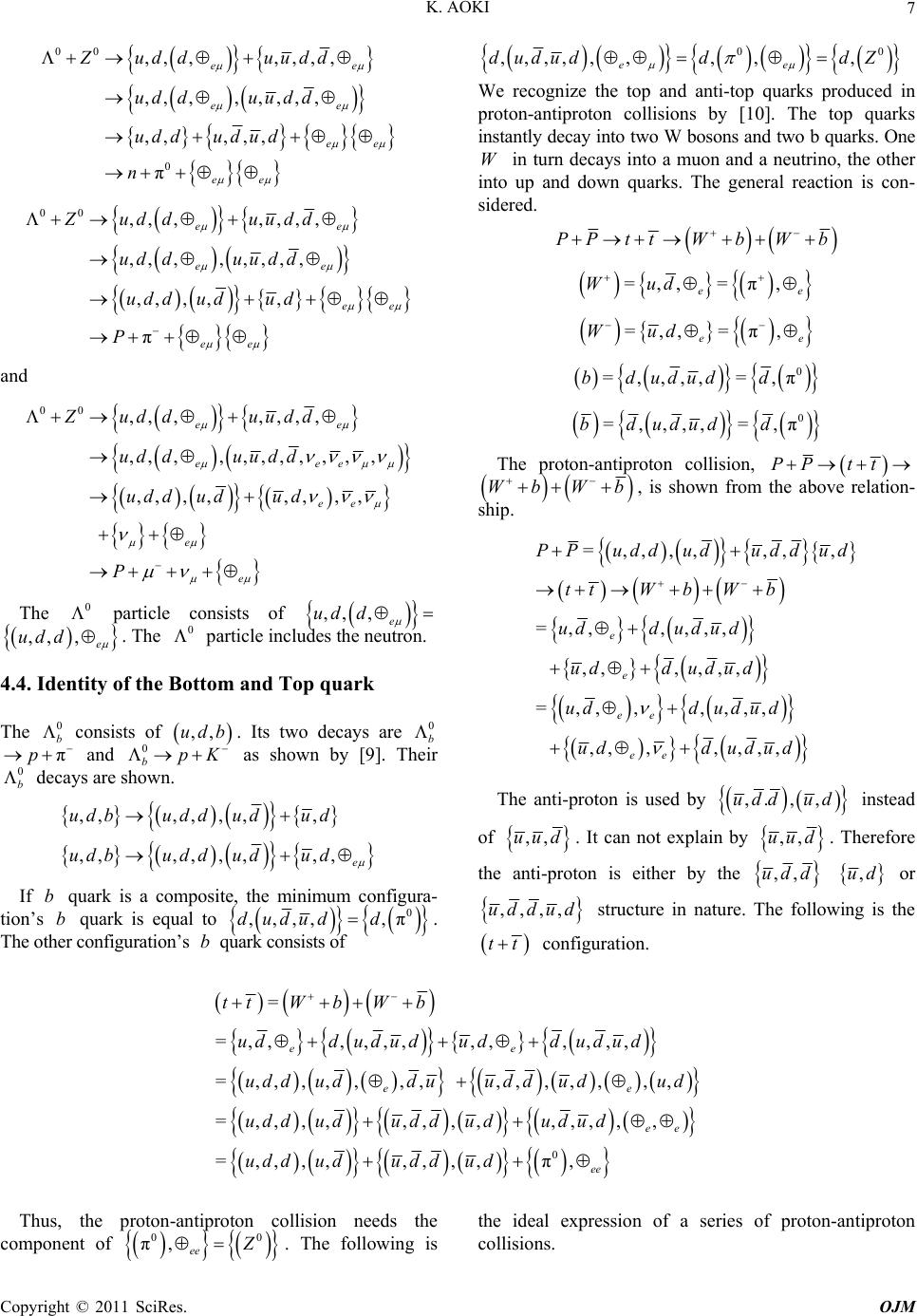 K. AOKI Copyright © 2011 SciRes. OJM 7 00 0 ,, ,,,,, ,,,,,,,, ,, ,,, π ee ee ee ee Zudduudd ud duudd udd udud n 00 ,,,,,,,,, ee dudud ddZ 00 ,,,,,,, ,,,,,,,, ,,, ,, π ee ee ee ee Zudduudd ud duudd udd udud P We recognize the top and anti-top quarks produced in proton-antiproton collisions by [10]. The top quarks instantly decay into two W bosons and two b quarks. One in turn decays into a muon and a neutrino, the other into up and down quarks. The general reaction is con- sidered. W PP ttWbWb =,,=π, ee Wud =,,=π, ee Wud 0 =,,,,=,πbdudud d and 00 ,,,,,,, ,,,,,,,,,,, ,,,,,,,, ee eee ee e e Zudduudd ud duudd udd udud P 0 =,,,, =,πbdududd The proton-antiproton collision, PP tt WbWb , is shown from the above relation- ship. =,,,,,, , =,,,,,, ,,,,,, =,, ,,,,, ,,,, ,,, e e ee ee PPuddududdud ttWbW b udd udud uddudud uddudud udd udud The particle consists of 0 ,,, e ud d ,e d ,,ud . The particle includes the neutron. 0 4.4. Identity of the Bottom and Top quark The consists of . Its two decays are 0 b ,,udb 0 b and as shown by [9]. Their decays are shown. πp 0 b pK 0 b ,,,,, ,, ,,,,,,,,e udbudd udud udbudd udud The anti-proton is used by ,. , ,uddud instead of ,,uud . It can not explain by ,,uud . Therefore the anti-proton is either by the ,,udd ,ud or ,,,,uddud structure in nature. The following is the tt configuration. If quark is a composite, the minimum configura- tion’s quark is equal to b b 0 ,,,,,πdududd. The other configuration’s quark consists of b 0 = =,,,,,, ,,,,,, =,,,,,,, ,,,,,,, =,,,,,,,,,,,, , =,,,,,,,, π, ee ee ee ee ttW bW b udd udududd udud uddudduud dudud uddudud dududud uddudud dud Thus, the proton-antiproton collision needs the component of 0 π,ee Z 0 . The following is the ideal expression of a series of proton-antiproton colisions. l  K. AOKI 8 0 0 ,,,,,,,,,,, ,,,, ,,,,, ,,,,, =,,,,,, ,,,,,,, , =,,, ,,, ,,,,,, ,,,,,, ,,,, ,,,(,, ee ee ee ee ee ee ee PPudd ududdud ttuddudduud dudud uudd udduudd udd unn unn WbWbudd udududdudud udd ududud 00 ,,,,, ,π,π ee ee dudud ed ed From the above nuclear reactions, the energy quanta air is a pair of and , not a pair ofp e ee and . Therefore we try to use the , e pair instead of the , ee o he expression such as the ex is considered ne. Tperiment llowingby the fo. 0 π,PP e or 0 0 2 00 ,,, ,,,,, π, ,,, ,,, (,,,,,,, π ,,,,, ,,, ,,, ,,,,, ,,,,, ,,,, ,π,π e e e ee PP Z uddudud dud tt udd uddu udd udud bWb uddudud udd udud uddudududv dudud ud dd The , e an the sy pair may be prefered through all reac- tions thmmetric experiment with the , ee pa itions of some hypothe- tical Higgs bosons by [11,12]. The light Higgs boson ir. Thons are not a two-body collision. 4.5. Identity of Higgs Boson ose reacti The followings show the compos 0 00 ,,,,, =π,,,π dudud dd The heavy Higgs bosons =, =,,,, light Hbb dudud 0 (1) 0 =, =,ud,,, =π, heavy ee ee HWW ud and 000 0 2 00 =,=,,, =π,π,, heavy ee HZZuuK 0 Z A neutral pion 0 π son. is the common minimum particle of Higgs bo 4.6. Identity of Pentaquark Composite It was reported on the evidence of pentaquark composite by [13]. ,,,,( )uud d sKpothers n K (.) ()n petccomposite () K pothers 4.6.1. Analisys The composition of pentaquark composite is analized. The following is the new expression. ,,,,() ()uuddsKPothers (.) ,π,, ,(.) () etccompositen Petc n KKPothers 00 πn P Copyright © 2011 SciRes. OJM  K. AOKI9 Next is the simple expression. 0 ,,,,,,,,,(,,),, ,,,, , ,,,,,, ,,,,,,,,, , ee e udd ud e ee nP udud udduddud ududd ud uddudududd ud nKKP This pentaquark composite consists of th energy quanta and the fimbers of quark. However this reaction can be also explained with the traditional proton ve me e ,,uud . ,, ,,,,,,,,, ,,,, ,,,,, ee e udud udd uud uddudud uud 0 π ,, ,,,,,, e ee np udd ududuud nKKp 4.7. Identity of the Debated Pentaquark Composite 4.7.1. 2005 JL Release, Pentaquark Debate Heats Up (April 28) ve quarks: two down quarksange quark.” by [14]. ab News It was reported that “Pentaquarks are built of fi for example, the is built of two up quarks, and an ant i-str 0ππpKKn 4.7.2. Results of Analysis The composition of composite is analized. The pro- ton decays with a neutral pion 0 π and some gamma- rays by a law of coion ober of partie. It is shown that the composiare nservat f num tions cl ,,,,,uddud e . It is an exotic composite. 0 π oPPr 00 0 =π or= =, π, ee e ee PPZ P 0 0 =,, =,,,, π=, π=, π=,,, =, =,, =π, =,,=, =,, e ee ee nudd Puddud ud ud udud sd Kud Kdd dsdd 4.7.3. Details of Analysis 0ππ ,,,, ,, ,,,, ,, e e PKKn ududd udud ududd udud etc The ,,udud etc must have the components of 0 K ,, e dd is e . The etc . 00 00 0 ,,,,,, ,, ,,,,,,, ,,,,, ,,,, ,, or, (I is PP P fπa kind of) e ee ee ee e ee ududd udud ududdud ud ud uddudud PPZ 4.7.4. Analized Description e 0 0 0 0 0 00 0 =, , =,, =, = ,,, ,,, ,,,,,, ,, ,,,,,,, ,,,, ,, ee ee e e ee ee ee P P P or nZ nK Z Z PuuK udd ududud ududdud ud ududd udud 0 0 0 ,, ,π, π,, π, ππ eu e ee e PK nZ n Kn Copyright © 2011 SciRes. OJM 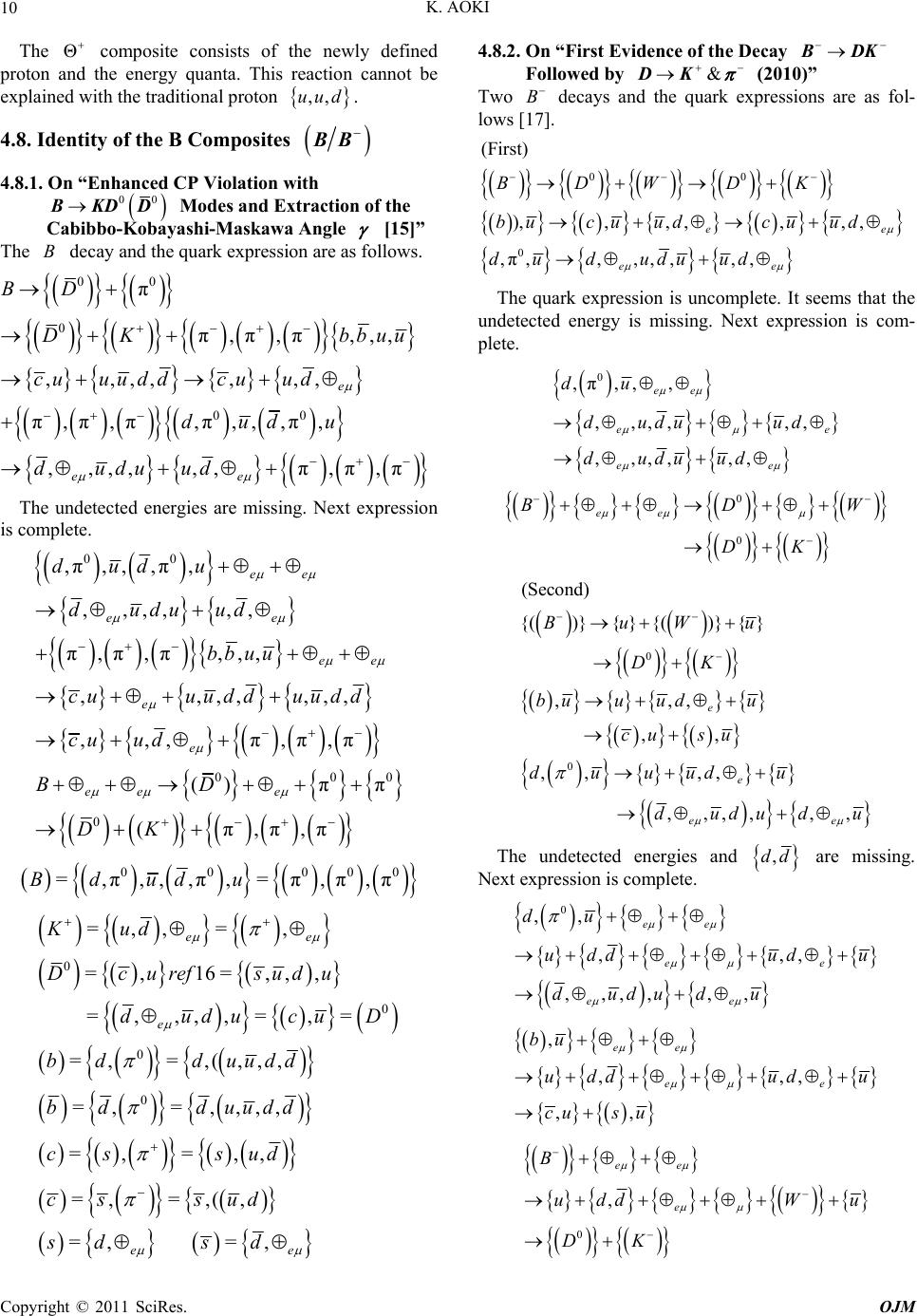 K. AOKI 10 The composite consists of the newly defined quanta. This reaction cannot be explaith the traditional proton 4.8. Identity of the B Composites Θ proton and the energy ned wi ,,uud . B B 4.8.1. On “Enhanced CP Violation with 00 B KD D Modes and Extraction of the ashi-Maskawa Angle Cabibbo-Kobay [15 The quark expression are as follows. ]” B decay and the ,, ,,,,π,π,π ee 00 0 00 π π,π,π,,, ,,,, ,,, π,π,π,π,,,π, e BD D Kbbuu cu uuddcu ud dudu Next expression du duud The undetected energies are missing. is complete. 00 000 0 ,, ,,,,, ,,,π,π,π () ππ (π,π,π e e ee e cuuudd uudd cu ud BD DK ,π,, ,π, ,,,, ,, ee ee dudu duduud π,π,π,,,ee bb uu 0 0000 =,π,, ,π,=π,π,πBdudu 0 0 0 0 =K ,, =, =, 16=,,, =,,,,=,= =, =,(,,, =, =,,,, =,=,, =, =,(, =, =, ee e ee ud Dcuref sudu duducuD bd duudd bd duudd cs sud cs sud sds d 4.8.2. On “First Evidence of the Decay B DK Followed by & DK (2010 Two )” B decays and tk expressi- lows [17]. he quarons are as fol 00 0 (First) ),,, ,,,, ,π,,,,,,, ee ee BDW DK bucu udcu ud du d uduud The quark expression is uncomplete. It seems that the undetected energy is missing. Next expression is com- plete. 0 ,π,,, ,,,, ,, ee ee du dudu ud ,, ,, ,, ee du duud 0 ee BDW 0 DK 0 0 (S eco n d) {()}{}{()} {} ,, ,, ,,,,,, e ee BuWu DK duuud u dududu The undetected energies and ,, , ,, e bu u udu cu su ,dd are missing. Next expression is complete. 0 ,, ,, ,,,, ,, ee ee ee du uddud u dududu , , ,, ,, ee ee bu uddud u cus u , 0 , ee e B uddW u DK Copyright © 2011 SciRes. OJM 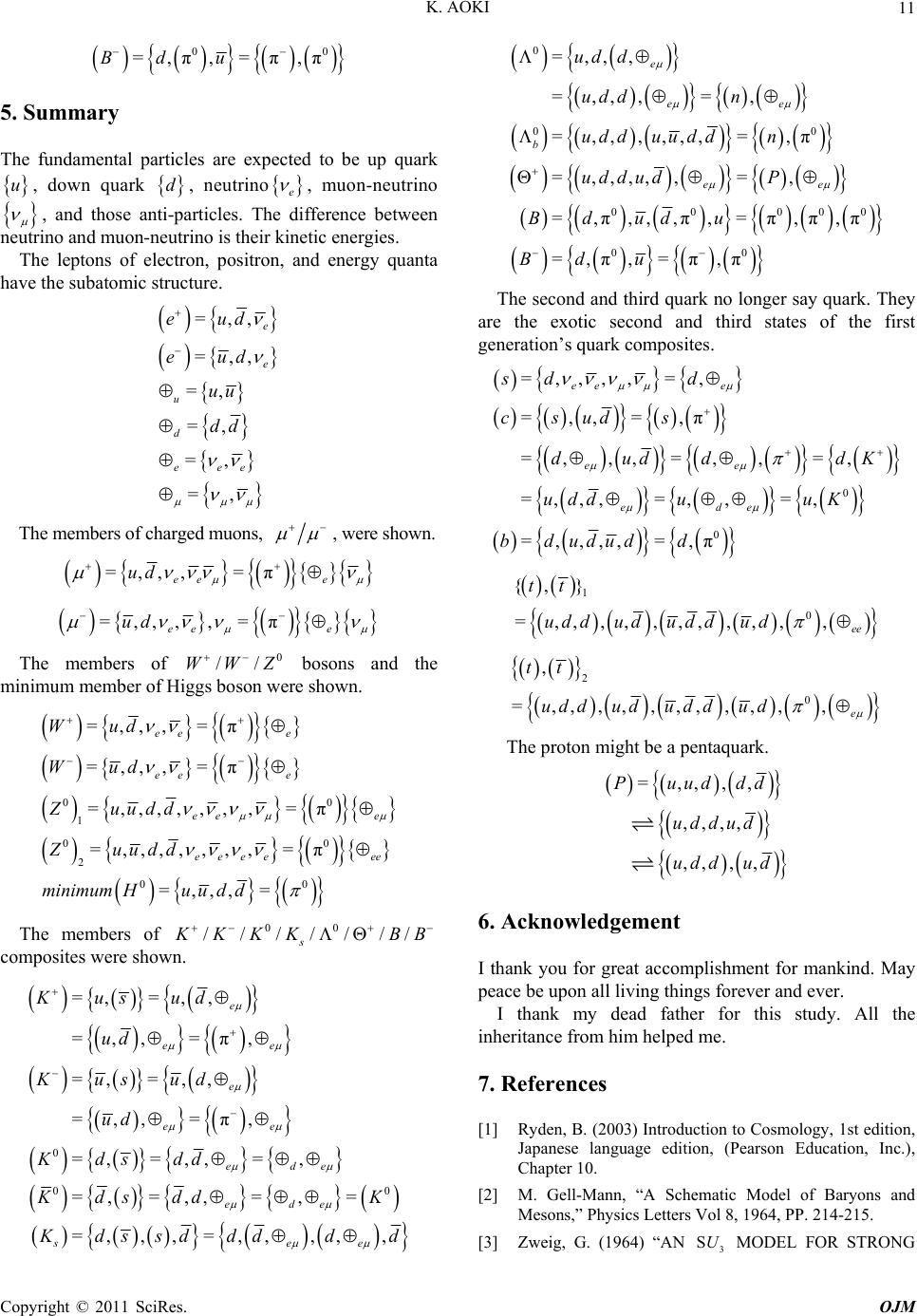 K. AOKI11 00 =,π,=πBdu ,π 5. Summary The fundamental particles are expected to be up qark , down quark u u d, neutrino e , muon-neutrino , and those anti-particles. The difference between no and muon-neutrino is their kinetic energies. The leptons of electron, positron, and energy qu nta have the subatomic structure. neutri a =,, =,, =, =, =, =, e e u d eee eud eud uu dd The members of charged muons, , were shown. =,,, =π ee e ud =,,, =πud , ee e he m The members of 0 //WWZ bosons and t inimum member of Higgs boson were shown. 00 1 00 2 00 =,,, =π =,,, =π =,,,,,,,=π = ,,,,,,,=π =,,, = ee e ee e ee e eeee ee Wud Wud Zuudd Zuudd minimumHu udd The members of 00 /////// s K KKK BB composites were shown. 0 00 =, =,, =,,=π, , =,=,,= , =,=,, =, = =,,, =,,,,, e ee e ede ede see Kusud ud d Kdsdd KdsddK =, =, =,, =π, ee Ku su ud 0 =,π,Bdu The second and third qu 0 00 0 0000 0 =,,, =,,,= , =,,,,,, =,π =,,,,,= , =,π,,,π,=π,π,π =π,π e ee b ee ud d udd n udd uuddn uddud P Bdudu ark no longer say quark. They are the exotic second and third states of the first generation’s quark composites. 0 0 = ,,,,= , =,,=,π =, ,,=, ,=, =,,, =,, =, =,,,,=,π ee e ee ede sd d csud s dudd dK udduuK bdudud d 1 0 {, } =,,,,,,,,,,, ee tt uddud uddud 2 0 , =,,,,,,,,,, , e tt uddud udd ud The proton might be a pentaquark. ,, ,,udd ud 6. Acknowledgement =,,,, ,,,, Puuddd uddud I thank you for great accomplishment for mankind. May peace be upon all living things forever and ever. I thank my dead father for this study. All t inheritance from him helped me. 7. References [1] Ryden, B. (2003) Introduction to Cosmology, 1st edition, Japanese language edition, (Pearson Education, Inc.), Chapter 10. [2] M. Gell-Mann, “A Schematic Model of Baryons and Mesons,” Physics Letters Vol 8, 1964, PP. 214-215. [3] Zweig, G. (1964) “AN MODEL FOR STRONG K ds sddddd he 3 SU Copyright © 2011 SciRes. OJM  K. AOKI Copyright © 2011 SciRes. OJM 12 INTERACTION SYMMETRY AND ITS BREAKING I,” CERN Reports 8182/TH.401 and “AN MODEL FOR STRONG INTERACTION SYMM AND ITS BREAKING II 8419/TH.412” [4] hysics of ph lecture course, Tokyo Metropolitan University. [5] A. Kernan, W. M. Powell, C. L. Sandler, W.L. Knight, and F. Russell Stannard, “Muonic-Decay Br Ratio of the Lambda Hyperon,” Phys. Rv. Vol 13 B1271-B1273. [6] Yuksel, H, (2006) “Positron Annihilations at the n 1. . Petrov, “Eff the charm scale in 3 U S ETRY ysics anching 3, 1964, Galactic swers,” ects from Hamatsu, R. (1990) High Energy P e Center: Generating More Questions Than A arXiv:astro-ph/0609139v [7] W. M. Yao et al. (Particle Data Group), “Review of Particle Physics,” J. Phys. G Vol 33, 2006, PP. 1-1232. and 2007 partial update for edition 2008, http://pdg.lbl.gov/ [8] A. F. Falk, A Lewandowski, A.A π+ K vv ,” Phys. Lett. B 107-112. [9] J.-E. Augustin et al., “Discovery of a Narrow Re al., “Identification of top quark D Vol 52, 1995, PP. . 325-335 and 05 by P. Igo-Kemenes. s. Rev kinematic variables,” Phys. Rev. R2605-R2609. [11] P. Igo-Kemenes, “Searches for Higgs bosons at LEP2,” J. Phys. G: Nucl. Part. Phys. Vol 24, 1998, PP Updated October 20 [12] P.W. Higgs, “Broken Symmetries and the Masses of Gauge Bosons,” Phy. Lett. Vol 13, 1964, PP. 508-509. [13] T. Nakano et al., “Evidence for a Narrow S = + 1 Baryon Resonance in Photoproduction from the Neutron,” Phys. Rev. Lett. Vol 91, 2003, PP. 012002. [14] JLAB News Release, (2005) Pentaquark debate heats up, http://www.jlab.org/divdept/diro/publicaairs/newsreleases /2005/pentaquarks.html [15] D. Atwood, I. Dunietz, and A. Soni, “Enhanced CP Violation with 00 B() K DD Modes and Extraction of the Cabibbo-Kobayashi-Maskawa Angle γ,” Phys. Rev. and Results,” Phys. Lett. B Vol 592, 2004, PP. Lett. Vol 78, 1997, PP. 3257-3260. [16] S. Eidelman, et al., “Charm Dalitz Plot Analysis Formalism Vol 505, 2001, PP. 1-1109. [17] Horii, Y, et al., (2010) First Evidence of the Decay BDK Followed by D&K sonance s using in ee Annihilation,” Phys. Rev. Lett. Vol 33, 1974, PP. 1406-1408. [10] F. Abe et , http://belle.kek.jp/results/summer10/dk_ads/. |

